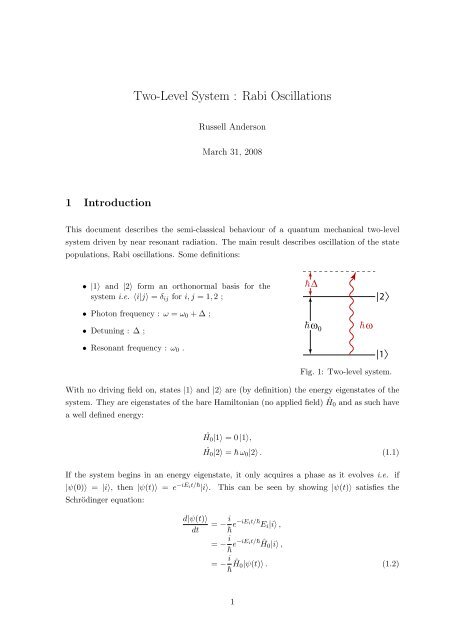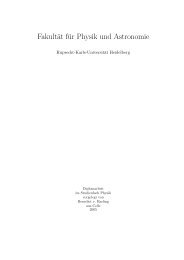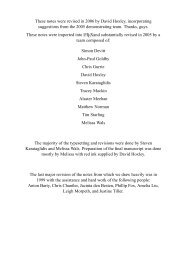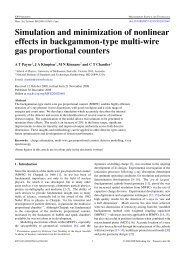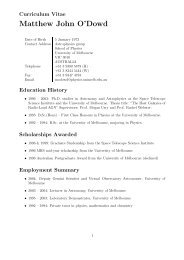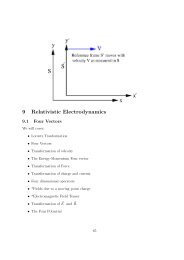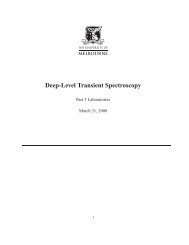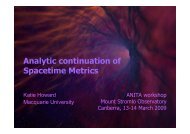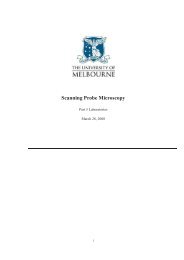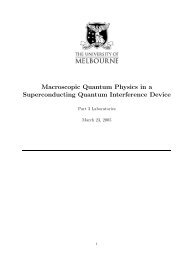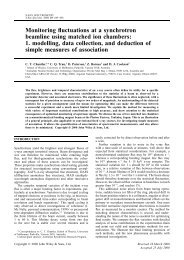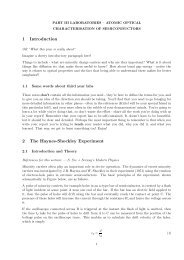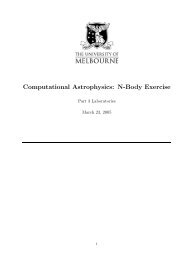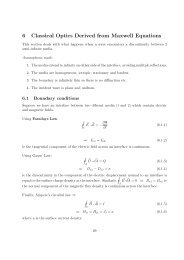Two-Level System : Rabi Oscillations
Two-Level System : Rabi Oscillations
Two-Level System : Rabi Oscillations
You also want an ePaper? Increase the reach of your titles
YUMPU automatically turns print PDFs into web optimized ePapers that Google loves.
<strong>Two</strong>-<strong>Level</strong> <strong>System</strong> : <strong>Rabi</strong> <strong>Oscillations</strong><br />
Russell Anderson<br />
March 31, 2008<br />
1 Introduction<br />
This document describes the semi-classical behaviour of a quantum mechanical two-level<br />
system driven by near resonant radiation. The main result describes oscillation of the state<br />
populations, <strong>Rabi</strong> oscillations. Some definitions:<br />
• |1〉 and |2〉 form an orthonormal basis for the<br />
system i.e. 〈i|j〉 = δ ij for i, j = 1, 2 ;<br />
∆<br />
|2<br />
• Photon frequency : ω = ω 0 + ∆ ;<br />
• Detuning : ∆ ;<br />
ω 0<br />
ω<br />
• Resonant frequency : ω 0 .<br />
|1<br />
Fig. 1: <strong>Two</strong>-level system.<br />
With no driving field on, states |1〉 and |2〉 are (by definition) the energy eigenstates of the<br />
system. They are eigenstates of the bare Hamiltonian (no applied field) Ĥ0 and as such have<br />
a well defined energy:<br />
Ĥ 0 |1〉 = 0 |1〉,<br />
Ĥ 0 |2〉 = ω 0 |2〉 . (1.1)<br />
If the system begins in an energy eigenstate, it only acquires a phase as it evolves i.e. if<br />
|ψ(0)〉 = |i〉, then |ψ(t)〉 = e −iEit/ |i〉. This can be seen by showing |ψ(t)〉 satisfies the<br />
Schrödinger equation:<br />
d|ψ(t)〉<br />
dt<br />
= − i e−iE it/ E i |i〉 ,<br />
= − i e−iE it/ Ĥ 0 |i〉 ,<br />
= − i Ĥ0|ψ(t)〉 . (1.2)<br />
1
Then, the probability of finding the system in the state |i〉 at any time is |〈i|ψ(t)〉| 2 =<br />
|e −iE it/ | 2 = 1. It is for this reason the energy eigenstates are called stationary states.<br />
Any two-level quantum state can be expressed as |ψ〉 = c 1 |1〉 + c 2 |2〉, where c 1 and c 2 are<br />
complex state amplitudes and |c 1 | 2 + |c 2 | 2 = 1. Such a state can be represented by a twocomponent<br />
vector;<br />
( )<br />
〈1|ψ〉<br />
ψ = =<br />
〈2|ψ〉<br />
( )<br />
c 1<br />
. (1.3)<br />
c 2<br />
The probability of finding the system in state |i〉 is |〈i|ψ〉| 2 = |c i | 2 , (for i = 1, 2).<br />
Any operator  can be represented by a 2 × 2 Hermitian matrix:<br />
The bare Hamiltonian Ĥ0 is then represented as:<br />
(<br />
)<br />
A =<br />
〈1|Â|1〉 〈1|Â|2〉<br />
〈2|Â|1〉 〈2|Â|2〉 . (1.4)<br />
H 0 = <br />
( )<br />
0 0<br />
. (1.5)<br />
0 ω 0<br />
What about the driving field? What does it do? It induces a dipole (electric or magnetic)<br />
moment between the states |1〉 and |2〉. The electromagnetic field interacts with this dipole,<br />
resulting in an oscillatory perturbation. This perturbation is represented by the operator:<br />
(<br />
)<br />
0 Ω cos(ωt)<br />
H int = <br />
Ω ∗ , (1.6)<br />
cos(ωt) 0<br />
where Ω = µE 0 , with µ the induced dipole moment and E 0 is the amplitude of the electromagnetic<br />
field. This interaction causes transitions between the two states. Why? Because<br />
Ĥ|i〉 ≠ α|i〉, (i = 1, 2 and α a constant), so the states |1〉 and |2〉 are no longer stationary<br />
states of the system. It is for this reason the two levels are said to be coupled by the applied<br />
field. We will now look at the time evolution of the system starting in state |1〉 under the<br />
application of an applied field.<br />
2
2 Dynamics<br />
2.1 Main Result : <strong>Rabi</strong> <strong>Oscillations</strong><br />
If the system begins at time t = 0 in state |1〉 and the field is applied, the state amplitudes<br />
evolve such that;<br />
( )<br />
|c 1 (t)| 2 = Ω2<br />
Ω 2 sin 2 ΩR t<br />
,<br />
R<br />
2<br />
( )<br />
|c 2 (t)| 2 = ∆2<br />
Ω 2 + Ω2<br />
R<br />
Ω 2 cos 2 ΩR t<br />
R<br />
2<br />
Ω 2 R ≡ Ω 2 + ∆ 2 .<br />
, (2.1)<br />
This means that the probabilities to be in state |1〉 or |2〉 oscillate with the frequency Ω R<br />
defined above, the total <strong>Rabi</strong> frequency. From this result, it is clear that states |1〉 and |2〉<br />
are no longer stationary states of the system. It is remarkable that the dynamic behaviour<br />
of the system is governed (at this point) by only two parameters. These parameters are the<br />
coupling strength Ω (proportional to the electromagnetic field strength) and the detuning ∆<br />
(how far the field is away from resonance).<br />
The applied field still induces transitions between the two states for frequencies not exactly on<br />
resonance (∆ ≠ 0). The solutions (2.1) show the contrast of the <strong>Rabi</strong> oscillations is dependent<br />
upon the detuning. Only on resonance do the populations oscillate completely between zero<br />
and unity. Away from resonance, the oscillations are faster but of lower amplitude. Also, for<br />
a fixed detuning, the frequency of the oscillations can be varied by changing the strength of<br />
the applied field. This is shown in the plots of Section 2.4.<br />
2.2 Derivation of <strong>Rabi</strong> <strong>Oscillations</strong><br />
The result above is derived by solving the Schrödinger equation in the interaction picture.<br />
This means that the time dependence of the Hamiltonian is removed by transforming to a<br />
“rotating frame”.<br />
Such a transformation is unitary (norm-preserving) and applied to the<br />
total Hamiltonian H = H 0 + H int . To see how this works, first we rewrite the Hamiltonian<br />
in the Schrödinger picture as (using equations (1.5) and (1.6)):<br />
(<br />
)<br />
H = 2<br />
0 Ω (e iωt + e −iωt )<br />
Ω ∗ (e iωt + e −iωt ,<br />
) 2ω 0<br />
(2.2)<br />
and define the following operator:<br />
( )<br />
0 0<br />
H 1 = . (2.3)<br />
0 ω<br />
3
Then, the new Hamiltonian (in the interaction picture, or “rotating frame”) is given by the<br />
following unitary transformation:<br />
The matrix corresponding to the new Hamiltonian is:<br />
Ĥ ′ = e iĤ1t/ (Ĥ − Ĥ1) e −iĤ1t/ . (2.4)<br />
( ) (<br />
) ( )<br />
H ′ = 1 0<br />
0 Ω (e iωt + e −iωt ) 1 0<br />
2 0 e iωt Ω ∗ (e iωt + e −iωt ) 2(ω 0 − ω) 0 e −iωt ,<br />
(<br />
)<br />
= 0 Ω (1 + e −i2ωt )<br />
2 Ω ∗ (1 + e i2ωt . (2.5)<br />
) −2∆<br />
We then make the rotating wave approximation, which is to ignore terms that oscillate at<br />
twice the driving frequency:<br />
(<br />
)<br />
H ′ = 0 Ω<br />
2 Ω ∗ . (2.6)<br />
−2∆<br />
To find the time evolution of the state amplitudes, the Schrödinger equation:<br />
d|ψ〉<br />
dt<br />
= − i Ĥ′ |ψ〉 , (2.7)<br />
is written in matrix form:<br />
( ) (<br />
) ( )<br />
ċ 1 (t)<br />
= − i 0 Ω c 1 (t)<br />
ċ 2 (t) 2 Ω ∗<br />
. (2.8)<br />
−2∆ c 2 (t)<br />
The <strong>Rabi</strong> frequency Ω can be made real by choosing the phase of the driving field to be zero.<br />
Then the differential equations for the state amplitudes are:<br />
ċ 1 (t) = − i 2 Ω c 2(t) ,<br />
ċ 2 (t) = − i 2 Ω c 1(t) + i∆ c 2 (t) ,<br />
c 1 (0) = 1 ,<br />
c 2 (0) = 0 . (2.9)<br />
The solution is:<br />
( )<br />
c 1 (t)<br />
= e it∆ 2<br />
c 2 (t)<br />
⎛<br />
(<br />
⎝ cos ΩR t<br />
2<br />
)<br />
− i ∆ Ω R<br />
sin<br />
)<br />
−i Ω Ω R<br />
sin<br />
(<br />
ΩR t<br />
2<br />
(<br />
ΩR t<br />
2<br />
) ⎞<br />
⎠ . (2.10)<br />
4
2.3 State transfer and Superpositions<br />
With the evolution of a system beginning in |1〉 known, consider driving the system on<br />
resonance (∆ = 0) for a fixed length of time, before turning the driving field off. There are<br />
two cases of interest, the π-pulse and the π 2<br />
-pulse. In each case, we can use equation (2.10)<br />
to find the resulting state.<br />
A π-pulse corresponds to turning the field on at t = 0 and off at t = T π ≡ π/Ω. Then:<br />
( )<br />
0<br />
ψ(T π ) = , (2.11)<br />
−i<br />
or equivalently:<br />
|ψ(T π )〉 = −i|2〉 . (2.12)<br />
Since an overall phase of a quantum state does not affect probabilities, this state is equivalent<br />
to |2〉, and a π-pulse is said to transform |1〉 into |2〉.<br />
A π 2 -pulse corresponds to turning the field on at t = 0 and off at t = T π<br />
2<br />
≡ π/(2Ω). Then:<br />
( )<br />
ψ(T π ) = √ 1 1<br />
, (2.13)<br />
2 2 −i<br />
or equivalently:<br />
|ψ(T π<br />
2 )〉 = 1 √<br />
2<br />
(|1〉 − i|2〉) . (2.14)<br />
This state is a special superposition, since the probability to be in either state |1〉 or |2〉 after<br />
a π 2 -pulse is 1 2 . 5
2.4 Plots of <strong>Rabi</strong> <strong>Oscillations</strong><br />
Below are plots of the probabilities to be in state |1〉 or |2〉 (solid and dashed lines, respectively)<br />
for various <strong>Rabi</strong>-frequencies and detunings (equations (2.1)):<br />
1.0<br />
⩵2Π,⩵0<br />
1.0<br />
⩵4Π,⩵0<br />
0.8<br />
0.8<br />
probabilities<br />
0.6<br />
0.4<br />
0.2<br />
probabilities<br />
0.6<br />
0.4<br />
0.2<br />
0.0<br />
0.0 0.5 1.0 1.5 2.0<br />
time<br />
0.0<br />
0.0 0.5 1.0 1.5 2.0<br />
time<br />
1.0<br />
⩵2Π,⩵2Π<br />
1.0<br />
⩵2Π,⩵4Π<br />
0.8<br />
0.8<br />
probabilities<br />
0.6<br />
0.4<br />
0.2<br />
probabilities<br />
0.6<br />
0.4<br />
0.2<br />
0.0<br />
0.0 0.5 1.0 1.5 2.0<br />
time<br />
0.0<br />
0.0 0.5 1.0 1.5 2.0<br />
time<br />
6


